|
1950 Vintage Crush 13,783 tons
Allocation was 4,448 tons to Wine and 9,335 tons to Spirit, 32.27%
Average Baume 12.89°
Doug. Collett was appointed Assistant Winemaker in June 1950.
Noel Burge resigned in July to return to assist his father at Wilsford Wines at Lyndoch.
From tapping into recollections from Noel Burge and reference to Doug. Collett's memoirs along with details from the newly formed Loxton Cooperative Winery and Distillery I believe the following events took place.
Noel Burge was asked by his father to return home to their Lyndoch winery. Noel had been promised a trip to California and had to decline. In June 1950 Doug. Collett had been appointed to the position of Assistant Winemaker and with Noel's departure in July 1950 was appointed Winemaker.
Roy Wilden started as Wine Records Clerk and joined Howard Penrhyn in the Technical Office.
March 1939
From records, BCWD had received a quotation in March 1939 for supply a continuous still.
On the 3rd May 1948 Lyle Nairn had Adel Friman send the following cable:
“Reference Double Column Continuous Still offered your letter March 1939 Please cable Present Cost And delivery Position”.
Blairs limited sent reply cable on 14th May 1948 as follows:
“Double Column Still offered March 1939 Price Now 8680 Sterling, Piping 880 Sterling. All FOB Glasgow Shipment 16 Months Can offer cheaper Double Column Still So Airmailing Details”.
Following the correspondence trail it was decided to proceed with bubble caps in both columns. Renmark Grower's Distillery had installed a Blair still some years ago using caps rather than the “Kuhni” plate. It was a wise decision in my opinion. I cannot find any correspondence providing the exact date of order.
Assistant Manager Alec. Kelly was in charge of the whole operation and Hugh Jennings, Managing Director of Coppersmiths H. H. Jennings Ltd, 27 Sturt Street, Adelaide and his staff would assist with the installation of the equipment. I was given a tour of the Stillhouse by Alec Kelly during the latter part of the 1951 vintage and the Blair still was operating at full steam.
Supplied by
Blairs Limited
Glasgow Engineering Works,
Woodville Street,
Govan, Glasgow
Job 3811, 3812, 3813, 3814, 3815/48
Comprising-Parts for Still.
Forwarded-16th December 1949
Per-S.S. “Eumaeus”
Consigned to-Order,
Nett Weight, 67-0-17
Gross Weight, 89-1-0
Cleared on 22nd March 1950 by H.M.Customs, No. 20, Port Adelaide.
Job 3809, 3810, 3816/48, 4913/49, 5150/49.
Comprising-Machinery, for Distillery.
Forwarded-6th January 1950.
Per-S.S.”Diomed”.
Consigned to-Order,
Nett Weight, 227-3-18,
Gross Weight, 310-3-10
Cleared on 29th March 1950 by H.M.Customs, No. 27, Port Adelaide.
The Blair Continuous Still components were installed after the 1950 vintage and replaced the Double Continuous Still that was installed in 1927. Noel Burge thought that the "Blair Still" was allowed in duty free since there not any firms that could build a comparable piece of equipment in Australia at that time.
Alec Kelly's daughter, Sue Vickers, says it was named 'Miss Blair". Alec Kelly and Ray Harrip worked many hours at night erecting the columns, condensers and ancillary pipe work and control equipment. I can remember Ray Harrip describing the method used to provide a flange seal. A layer of red lead was painted onto both flange surfaces. On the lower flange the securing bolts were supported underneath and two strands of pipe thread were woven in opposite directions around the bolts and another coating of red lead was painted onto the thread strands and then the upper flange section was lowered and the nuts were applied to the bolts and the two flanges were joined using the 180° and 90° angle nut tightening method. It proved to be a very effective seal method and minimal leaks occurred over the next 20 years.
The shot is looking west towards Glossop and on the left is the steam pressure controller which regulated the steam flow to the analyser (stripping) column, next right is the rectifying (concentrating) column and extreme right is a final condenser cooler for Pot Rectifier No.3 and its try safe is at the bottom left of the condenser. In the left foreground you can see three spirit and/or feints receivers (tanks). These were painted black for spirit, which was the final product and blue for feints which would be redistilled.
The Blair Continuous Still Control Panel with the mix of motor switches, valves, thermometers, temperature and pressure recorders, flowrators and try safes. This was positioned on the north wall of the Stillhouse on the first floor. There was a mass of electrical cables, piping and valves behind the board.
View of the the three Pot stills and to the right rear of the central pot is the brandy ball column. Behind the far Pot Column is the Blair still control panel. You can see the large drain valves at the bottom of each pot still and running on the left of the stills is a large drain which had two functions. When processing any wine source the spent wash could be delivered to Tarac by a dedicated pipeline and if the charge had been "low wines" or feints then spent liquor would be directed to the effluent ponds. Check with Russell Frost and Tarac Story.
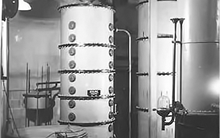 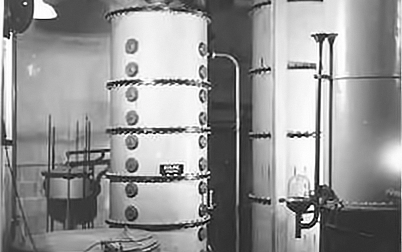
|
The
shot is looking west towards Glossop and on the left is
the steam pressure controller which regulated the steam
flow to the analyser (stripping) column, next right is the
rectifying (concentrating) column and extreme right is a
final condenser cooler for Pot Rectifier No.3 and its try
safe is at the bottom left of the condenser. In the left
foreground you can see three spirit and/or feints receivers
(tanks). These were painted black for spirit, which was
the final product and blue for feints which would be redistilled.
|
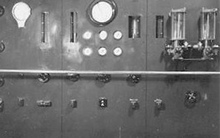 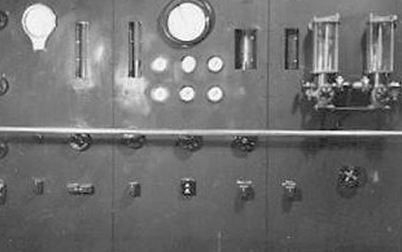
|
The Blair Continuous Still Control Panel with the mix of motor switches, valves, thermometers, temperature and pressure recorders, flowrators and try safes. This was positioned on the north wall of the Stillhouse on the first floor. There was a mass of electrical cables, piping and valves behind the board.
|
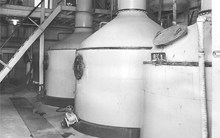 
|
View of the three Pot stills and to the right rear of the
central pot is the brandy ball column. Behind the far Pot
Column is the Blair still control panel. You can see the
large drain valves at the bottom of each pot still and running
on the left of the stills is a large drain which had two
functions. When processing any wine source the spent wash
could be delivered to Tarac by a dedicated pipeline and
if the charge had been "low wines" or feints then
spent liquor would be directed to the effluent ponds. Check
with Russell Frost and Tarac Story.
|
|











